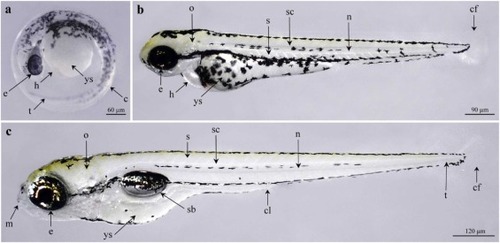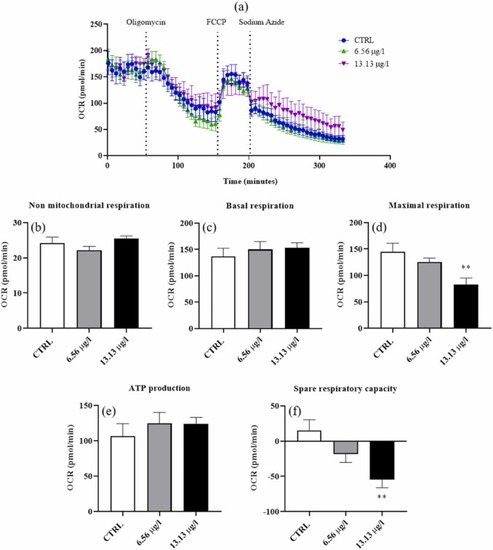- Title
-
Effect of short-term exposure to the strobilurin fungicide dimoxystrobin: Morphofunctional, behavioural and mitochondrial alterations in Danio rerio embryos and larvae
- Authors
- Ahmed, A.I.M., Macirella, R., Talarico, F., Muoio, M.F., Mezzasalma, M., Tronci, V., Lal, P., Gharbi, N., Brunelli, E.
- Source
- Full text @ Ecotoxicol. Environ. Saf.
|
Gross morphology of zebrafish embryos and larvae under basal conditions. (a) At 30 hpf, embryos within the chorion display a prominent yolk sac and high-pigmented eyes. Note the pericardial cavity and the developing tail. (b) At 54 hpf, most of the larvae are out of the chorion and show a prominent yolk sac. The eyes, otoliths, heart, spinal cord, and notochord are visible. The somites are well distinguishable, and the caudal fin is formed. (c) At 102 hpf, all larvae have an inflated swim bladder. The caudal fin, otoliths and eyes are further developed. c=chorion, ys=yolk sac, e=eyes, h=heart, t=tail, o=otolith, cf=caudal fin, sc=spinal cord, n=notochord, s=somites, m=mouth, sb=swim bladder, cl=cloaca. |
|
Gross morphology of zebrafish embryos and larvae exposed to 6.56 µg/L of dimoxystrobin. (a,b) After 24 h of exposure, embryos exhibit yolk sac swelling and spinal deformity. (c,d) After 48 h of exposure, tail deformity and pericardial edema appear. (e,f) After 96 hours of exposure, yolk sac swelling and pericardial edema are more frequent and severe. Note the alteration of the swim bladder. sys=swelling of yolk sac, sd=spinal deformity, td=tail deformity, pe=pericardial edema, usb=uninflated swim bladder. |
|
Gross morphology of zebrafish embryos and larvae exposed to 13.13 µg/l of dimoxystrobin. (a,b) After 24 h, embryos show severe yolk sac swelling. Spinal deformity, tail deformity, and pericardial edema can be frequently detected. (c,d) After 48 h of exposure, the frequency of pericardial edema and tail deformity increases. (e-f) After 96 h of exposure, larvae show severe pericardial edema, yolk sac swelling, and spinal and tail deformities. The alteration of the swim bladder is visible in all larvae. sys=swelling of yolk sac, sd=spinal deformity, td=tail deformity, pe=pericardial edema, usb=uninflated swim bladder. |
|
(a) Oxygen consumption rate (OCR) of zebrafish embryos after 48 hours of exposure to 6.56 and 13.13 µg/L of dimoxystrobin. (b-f) Mitochondrial parameters. (b) non-mitochondrial respiration, (c) basal respiration, (d) maximal respiration, (e) ATP production, (f) spare respiratory capacity. Asterisks indicate significant differences between the exposed and unexposed groups (**p<0.01). Data are presented as mean±standard error of the mean (SEM). |
|
(a-c) Locomotor activity of zebrafish larvae after 96 hours of exposure to 6.56 and 13.13 µg/L of dimoxystrobin. (a) Swimming distance of zebrafish larvae in 1 min, (b) total distance moved and (c) velocity. Asterisks indicate significant differences between the exposed and unexposed groups (**p<0.01). (d) Total distance moved vs. swim bladder volume; Pearson correlation coefficient (r=-0.9999; p=0.0089**). Data are presented as mean±standard error of the mean (SEM). |
|
Gene expression in zebrafish larvae after 96 hours of exposure to 6.56 and 13.13 µg/l of dimoxystrobin. Relative mRNA expression of NADH dehydrogenase (a), ubiquinol-cytochrome c reductase (b), cytochrome c oxidase (c), ATP synthase F0 subunit 6 (d). Asterisks indicate significant differences between the exposed and unexposed groups (*p<0.05; **p<0.01; ****p<0.0001). Hashtags indicate significant differences between high-concentration and low-concentration groups (###p<0.001). Data are presented as mean±standard error of the mean (SEM). |






